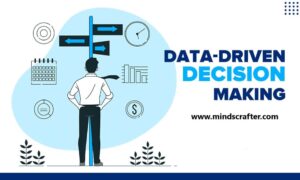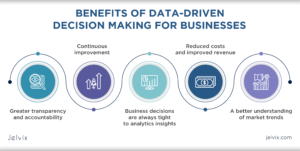
data-driven decision making
Why Data-Driven Decision-Making is Essential for Business Growth
In today’s fast-paced business landscape, data-driven decision-making has become essential to achieving sustainable growth. Gone are the days when gut instincts–a feeling that you are certain is right, and assumptions ruled the business world, as companies increasingly rely on data to make informed decisions. Data has become the fuel that drives the decision-making process, enabling businesses to identify patterns and trends, uncover hidden insights, and optimize their operations for maximum efficiency. Whether a small startup or a multinational corporation, data-driven decision-making can help you stay ahead of the competition, minimize risks, and seize new opportunities.
Finally, this short article will explore why data-driven decision-making is crucial for business growth and success and how you can leverage data to make smarter decisions that drive results.
The Importance of Data-Driven Decision-Making in Business Growth
Data-driven decision-making is crucial for business growth and success. It enables businesses to identify patterns and trends, uncover hidden insights, and optimize their operations for maximum efficiency. By leveraging data, companies can make informed decisions that drive results, stay ahead of the competition, minimize risks, and seize new opportunities. So, in today’s fast-paced business environment, where competition is fierce, and margins are slim, data-driven decision-making can be the difference between success and failure.
For example, consider the success of Netflix, a company that uses data-driven decision-making to drive growth and profitability. Netflix uses data to analyze user behaviour, preferences, and viewing habits, enabling it to create personalized recommendations and content that keeps users engaged and subscribed. By leveraging data, Netflix has grown its subscriber base and revenue, becoming one of the most successful streaming services in the world.
Another example of a company that uses data-driven decision-making is Amazon. Amazon uses data to personalize the customer experience, optimize logistics and supply chain operations, and drive sales and profitability. By leveraging data, Amazon has been able to stay ahead of the competition, expand its product offerings, and become one of the most successful e-commerce companies in the world.
Examples of Successful Companies Using Data-Driven Decision Making
Many successful companies use data-driven decision-making to drive growth and profitability. One example is Google, which uses data to optimize its search algorithms, personalize search results and drive advertising revenue. Further, google also uses data to analyze user behaviour, preferences, and interests, which enables them to create personalized ads that are more relevant and engaging for users.
Another example of a company that uses data-driven decision-making is Uber. Uber uses data to optimize its pricing, routes, and driver allocation, providing users a more efficient and cost-effective service. By leveraging data, Uber has been able to disrupt the traditional taxi industry, expand its services globally, and become one of the most successful ride-hailing companies in the world.
A third example of a company that uses data-driven decision-making is Facebook. Facebook uses data to personalize the user experience, optimize its advertising algorithms, and drive engagement and revenue. By leveraging data, Facebook has become one of the world’s most successful social media platforms, with over 2 billion active users.
Common Challenges in Implementing Data-Driven Decision Making
While data-driven decision-making can significantly benefit businesses, it has challenges. One of the most common challenges is the availability and quality of data. Many companies need help to collect and analyze data effectively, leading to inaccurate or incomplete insights. Another challenge is the complexity of data analysis, which requires specialized skills and expertise that may only be available in some places.
A third challenge is the integration of data into the decision-making process. Many businesses need help incorporating data into their decision-making processes, relying instead on traditional methods such as gut instincts and assumptions. This can lead to missed opportunities, poor decision-making, and suboptimal outcomes.
Steps to Becoming a Data-Driven Organization
To become a data-driven organization, businesses must take a strategic approach to data collection, analysis, and integration. The following are some steps that companies can take to become more data-driven.
- Define clear goals and objectives: Businesses must define clear goals and objectives aligning with their vision and strategy. This will help them focus their data collection and analysis efforts on the most critical areas of their business.
- Identify key metrics: Businesses need to identify key metrics to help them measure progress towards their goals and objectives. These metrics should be specific, measurable, and relevant to their business.
- Collect and analyze data: Businesses must collect and analyze data from various sources, including customer feedback, sales data, website analytics, and social media metrics. They should also use tools and technologies that enable them to analyze data in real time and uncover hidden insights.
- Incorporate data into decision-making: Businesses need to incorporate data into their decision-making processes, using insights from data analysis to inform their decisions. This can be done through dashboards, reports, and other visualization tools that enable businesses to see the big picture and make informed decisions.
- Continuously improve: Businesses must continuously improve their data collection and analysis processes, monitoring key metrics and refining their approach as needed. They should also invest in training and development to build the skills and expertise to become more data-driven.
Tools and Technologies for Data-Driven Decision Making
There are many tools and technologies available that can help businesses become more data-driven. Some of the most popular tools include:
- Business intelligence software: Business intelligence (BI) software enables businesses to collect, analyze, and visualize data from various sources. BI software can help businesses identify trends, patterns, and insights that might be missed.
- Data visualization tools: Data visualization tools enable businesses to create interactive dashboards and reports that make it easy to understand complex data. These tools can help businesses identify trends and patterns and make informed decisions based on data insights.
- Machine learning algorithms: Machine learning algorithms can help businesses uncover hidden insights and patterns in data, enabling them to make more accurate predictions and decisions. Machine learning algorithms can be used for various purposes, including customer segmentation, product recommendations, and fraud detection.
- Cloud computing: Cloud computing enables businesses to store and analyze large amounts of data cost-effectively and cost-effectively. Cloud platforms like Amazon Web Services (AWS) and Microsoft Azure provide companies access to powerful data analysis tools and technologies without expensive hardware or infrastructure.
How to Collect and Analyze Data Effectively
Collecting and analyzing data effectively is crucial for businesses that want to become more data-driven. The following are some tips for collecting and analyzing data effectively.
- Define clear objectives: Businesses must define unique data collection and analysis goals. This will help them focus their efforts on the most critical areas of their business and ensure that they are collecting relevant and valuable data.
- Use multiple sources: Businesses should use various data sources, including customer feedback, sales data, website analytics, and social media metrics. This will give them a complete picture of their business and help them identify trends and patterns that might otherwise be missed.
- Analyze data in real-time: Businesses should analyze data in real-time, using tools and technologies that enable them to monitor key metrics and identify trends as they happen. This will enable them to make informed decisions quickly and stay ahead of the competition.
- Use visualization tools: Visualization tools such as charts, graphs, and dashboards can help businesses visualize complex data and quickly identify trends and patterns. Finally, these tools can also help businesses communicate data insights more effectively to stakeholders.
Key Metrics to Track for Business Growth
Tracking key metrics is crucial for businesses that want to achieve sustainable growth. The following are some key metrics that businesses should track.
- Revenue: Revenue is the most critical business metric, reflecting the organization’s financial health. Businesses should track revenue by product or service line, customer segment, and geography.
- Customer Acquisition Cost (CAC): CAC is the cost of acquiring a new customer and is an essential metric for businesses that want to grow their customer base. So, businesses should track CAC by marketing channel and work to minimize it through targeted marketing campaigns and improved customer retention.
- Customer Lifetime Value (CLV): CLV is the total value of a customer over their lifetime and is an essential metric for businesses that want to maximize customer profitability. So, companies should track CLV by customer segment and work to increase it through targeted marketing campaigns, improved customer service, and product innovation.
- Net Promoter Score (NPS): NPS measures customer satisfaction and loyalty and is essential for businesses that want to improve customer retention and referral rates. So, companies should track NPS by customer segment and work to improve it through targeted marketing campaigns, improved customer service, and product innovation.
Benefits of Data-Driven Decision-Making for Employees and Customers

Data-driven decision-making can provide significant benefits for both employees and customers. For employees, data-driven decision-making can help improve job satisfaction, enabling them to make more informed decisions and take a more proactive approach to their work. Further, it can also help improve employee productivity, allowing them to work more efficiently and effectively.
Additionally, for customers, data-driven decision-making can help improve the customer experience, enabling businesses to personalize their offerings and provide more relevant and engaging products and services. Moreover, it can also help improve customer satisfaction, allowing companies to offer more effective customer service and resolve issues more quickly and efficiently.
Conclusion on the Future of Data-Driven Decision-Making in Business
Data-driven decision-making is essential for businesses that want sustainable growth and success. By leveraging data, companies can identify patterns and trends, uncover hidden insights, and optimize their operations for maximum efficiency. Furthermore, they can also stay ahead of the competition, minimize risks, and seize new opportunities. While there are challenges to implementing data-driven decision-making, the benefits far outweigh the costs.
Finally, with the right tools, technologies, and approaches, businesses can become more data-driven and unlock the full potential of their data to drive growth and profitability.
